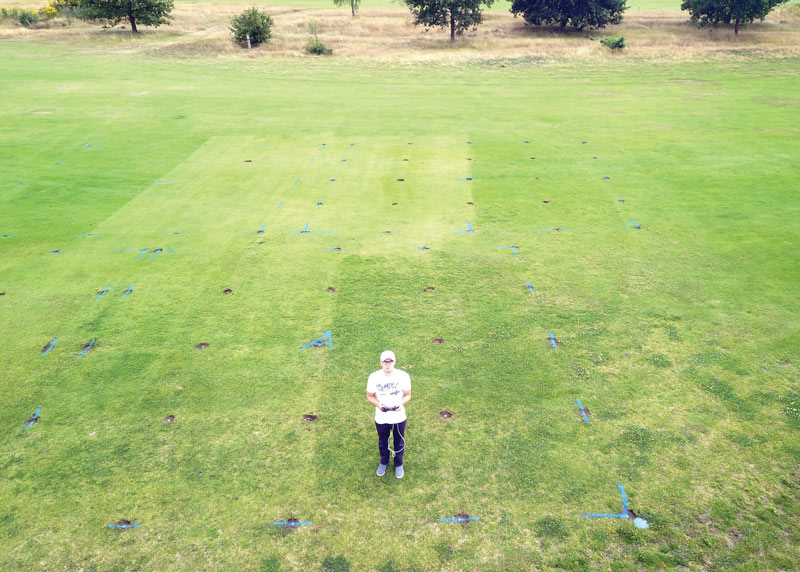
Graduate student Daniel Hahn uses a drone to photograph an area at Golfclub Heelsum in the Netherlands, where researchers are investigating the interaction of mowing height and fertility on weed encroachment of golf course fairways. Photo by Daniel Hahn
The occurrence of weeds in turfgrass stands is not uncommon, but in most cases, weeds do not become a serious problem if the turfgrass is well managed and properly maintained. Dense, vigorously growing turfgrass that is not under stress will normally resist invasion by weeds. However, turfgrasses on golf courses are subjected to compaction and low mowing heights that can contribute significantly to turfgrass stress, making it easier for weeds to invade, even under optimal management (2).
High-quality turf is desirable on golf courses, and herbicides are an effective tool that has long been used to suppress weeds. But what happens when herbicides are no longer an option? In Europe, strict bans and restrictions have been introduced on herbicide use on turfgrasses in response to concerns about herbicide resistance, health risks associated with herbicide exposure, and environmental concerns. It is clear that the future of weed control of turfgrasses in Europe will be limited to non-chemical herbicide strategies.
In the United States and Canada, similar concerns have led to a growing number of turfgrass areas that have adopted no-herbicide policies as well. In a world where herbicides may not always be an option, it is incumbent on us to re-examine strategies and management practices to control weeds in these challenging environments without the use of synthetic herbicides. A recently published journal article summarized the management options and future research trends to address this important issue (7).
Turfgrass selection
Selecting cultivars that germinate and establish quickly in newly seeded areas is an important first step in reducing the chance of weed germination. The selected cultivar should be adapted to the local climate and show resistance to local biotic stresses, such as insects and diseases, as these can weaken the turf stand and make it more susceptible to weed infestations. Selected cultivars should also be able to withstand abiotic stresses, such as drought, salinity, lack of nutrients and low mowing heights, which can increase a turf stand’s susceptibility to colonization by weeds.
Every year, the National Turfgrass Evaluation Program ranks the majority of turfgrass cultivars for various characteristics, including visual appearance, resistance to biotic and abiotic stress, disease resistance, and recovery. These turfgrass trials provide managers with valuable information they can use to select cultivars that establish and grow vigorously, are adapted to the local climate, and are able to withstand biotic and abiotic stresses, all of which help them outcompete weeds.
Seeding and overseeding strategies
Overseeding has been shown to be a successful strategy to reduce weed populations, provided that sufficient seed germination is achieved (10). Best practices to increase germination after overseeding and suppress weeds include overseeding during periods of reduced weed growth, providing good seed-soil contact, and following a fertilizer regime. Both phosphorus and nitrogen are required during establishment to facilitate shoot and root growth.
Adjusted mowing practices
Increasing mowing heights has been shown to help control certain turfgrass weeds such as crabgrass and annual bluegrass (Poa annua). However, this strategy may have limited applicability to golf courses, where mowing heights are defined based on playability. Furthermore, no studies have demonstrated that weed pressure on golf fairways is reduced by changing mowing heights.
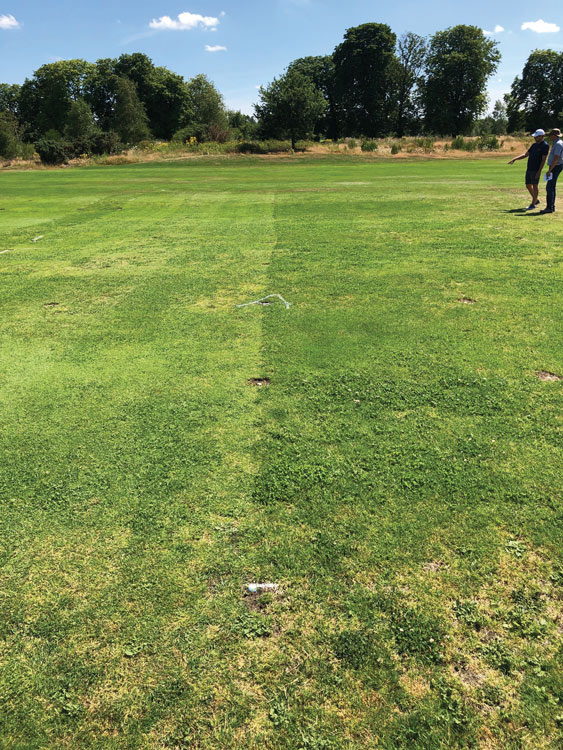
A fairway at Golfclub Heelsum in the Netherlands was the site of an experiment to investigate the effects of the interaction of mowing height and fertility applications on weed encroachment in golf course fairways. Plots on the left were mowed at a height of 0.39 inch (10 millimeters), and those on the right at 0.59 inch (15 millimeters). Photo by Bernd Leinauer
While returning clippings to turfgrass is thought to increase soil levels of nutrients, it has also been shown to add weed seeds, particularly those of annual weeds, such as annual bluegrass. Clipping removal has been shown to reduce viable annual bluegrass seeds substantially in bentgrass-dominated turfgrass (6) and is recommended where turfgrass is dominated by unwanted annual bluegrass.
Editor’s note: Got Poa? Get control strategies, herbicide resistance information and more in GCM’s collection of Poa annua resources.
Fertilization
Fertilization is another tool that encourages dominance of desirable turfgrass species through competitive exclusion. In the absence of synthetic herbicides, turfgrass managers may need to re-examine some traditional fertilization practices that have fallen out of favor because of budgetary constraints and environmental concerns.
Higher fertilization rates have been shown to provide turfgrasses with a competitive edge over broadleaf weeds (3) and crabgrass (4). However, higher rates are now discouraged because of fertilizer costs, risks of groundwater contamination, and surface runoff of excess fertilizer to receiving surface waters. Estimating minimum levels of nitrogen required to provide turfgrass with a competitive edge over weeds can be difficult. Turfgrass managers should focus on limiting nitrogen applications to the minimum amounts needed to produce acceptable playing quality or aesthetic appeal, which may vary depending on expectations, budget limitations and ecological considerations.
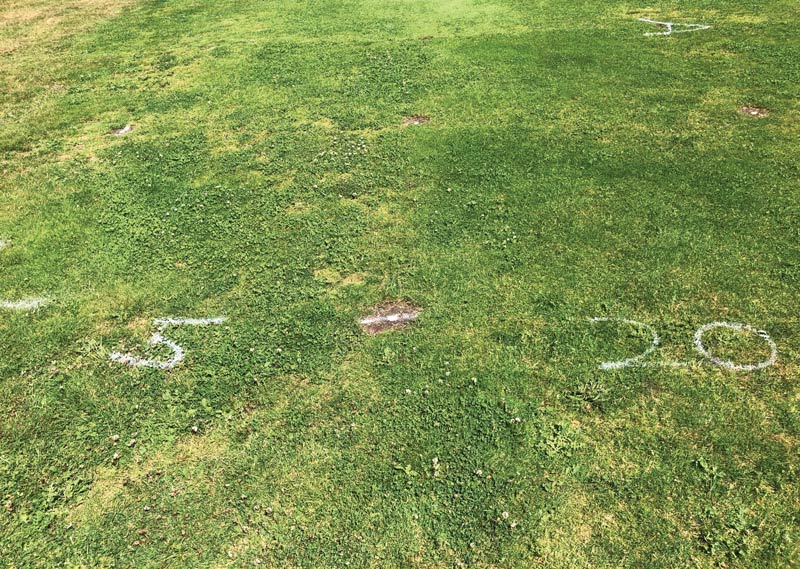
These plots are part of research to examine the interaction of mowing height and fertilizer rate on weed encroachment of golf course fairways. Left: Plot fertilized with 5 grams nitrogen/square meter/year. Right: Plot fertilized with 20 grams nitrogen/square meter/year. Photo by Bernd Leinauer
Although nitrogen fertilization assists turfgrass in maintaining dominance over broadleaf weeds, it has been shown to increase production of annual bluegrass, which outcompetes desirable turfgrass species (5). Strategies to outcompete annual bluegrass include reducing nitrogen applications and acidifying the soil by applying sulfur. Long-term applications of ammonium sulfate to lower soil pH have also been shown to reduce broadleaf weed populations.
Bioherbicides
With the growing demand for alternatives to synthetic herbicides for weed control, bioherbicides have gained significant attention in recent years. Bioherbicides consist of living microorganisms or products derived from microorganisms that can be used for biological control of weeds. These include compounds and metabolites derived from fungi, bacteria or protozoa, or compounds derived from plants that have phytotoxic properties. Several bioherbicides are being studied for efficacy; a few are currently registered and available in commercial forms for selective weed control in turfgrasses.
Toxic metabolites produced by fungi belonging to the genus Phoma have been extensively studied for their herbicidal properties. The fungus Phoma macrostoma was registered for broadleaf weed control in turfgrass in Canada in 2011 and in the United States in 2012 (12). It was granted full registration for sale and use in Canada and may be used to control various weeds such as common dandelion, white clover, Canada thistle, common chickweed, common plantain and common ragweed. The fungus Sclerotinia minor has also shown promise in controlling broadleaved weeds such as dandelion, white clover and broadleaved plantain, and the isolate IMI 344141 was identified as a suitable candidate for the production of bioherbicides (1).
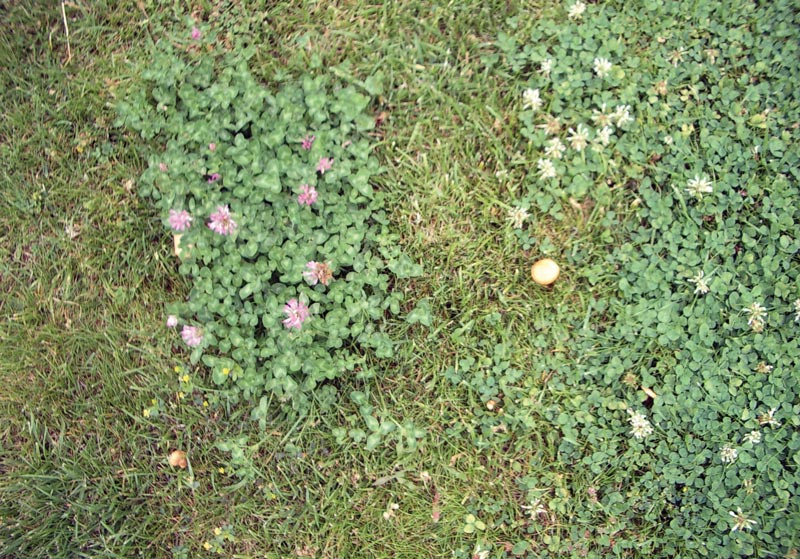
Clover is one of the most troublesome weeds on golf courses in Central and Northern Europe. Photo by Bernd Leinauer
Several strains of Pseudomonas fluorescens have been shown to control annual bluegrass and certain graminaceous plants. Currently, P. fluorescens strain D7 is registered for the control of agricultural weeds but not annual bluegrass. The bacterium Xanthomonas campestris has been found to be pathogenic to annual bluegrass while not affecting other turfgrasses. In Japan, X. campestris pathovar Poa annua was formulated into a commercially available product (11). Even though some of these products are on the market, research that compares their efficacy with that of synthetic herbicides is limited.
Organic herbicidal products
Corn gluten meal has been extensively studied for its purported herbicidal properties on annual grassy weeds and agricultural plant weed species. However, other studies question the claims of herbicidal activity of corn gluten meal and suggest that its high nitrogen levels simply provide turfgrasses with a competitive advantage, allowing them to outcompete weeds. The conclusion drawn from all of these studies is that corn gluten meal is a good source of organic nitrogen but should not be considered an organic alternative to synthetic herbicides used to control weeds in turfgrasses.
Acetic acid can be used to control turfgrass weeds. In the U.S., acetic acid products containing less than 8% active ingredient do not need registration and can effectively control young weeds with one to two leaves. Improved control is achieved using higher concentrations of acetic acid and greater application volumes. Effectiveness is dependent upon maximizing the area of contact with the foliage.
Thermal weed control
Thermal weed control can be used to sterilize a seed bank or spot-spray or burn existing weeds. Flaming was shown to control broadleaved and grassy weeds effectively prior to tall fescue establishment (8). Steaming soil could be an alternative to pre-emergence herbicides to treat newly constructed turfgrass areas. For spot-treating weeds, hot water was found to be more effective than flaming, steam or hot air (9).
Soil solarization is another method of thermal killing that uses the sun’s power to heat the soil to temperatures that kill weeds and weed seeds. The procedure involves covering the ground with a tarp, usually transparent polyethylene, to trap solar energy. This method may be practical only for small turfgrass areas, as installing plastic covers is labor-intensive, and covers need to be in place for at least four weeks. Other thermal weed control methods include freezing, electric currents, irradiation, microwave radiation and ultraviolet light.
Allelopathic potential
The concept of allelopathy is receiving increasing attention in the search for non-chemical strategies to control weeds. Allelopathy is the biological phenomenon whereby one plant suppresses the growth of another plant by releasing into the environment biochemicals that act as growth inhibitors. The capacity of turfgrasses to produce allelopathic substances that influence weed invasion has been reported for a variety of turfgrasses.
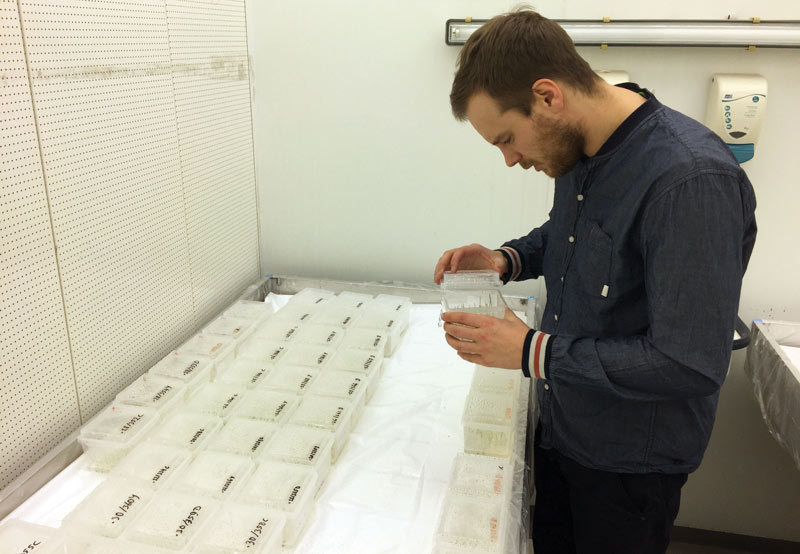
Doctoral student Daniel Hahn looks at the results of a germination experiment designed to determine whether various tall and fine fescue species interfere with germination of weed species. Photo by Bernd Leinauer
Allelopathy-based breeding programs are being developed to select for allelopathic turfgrass varieties. Once allelopathic cultivars or species demonstrating strong competitiveness against weeds have been identified, turfgrass managers should consider establishing these species over time.
Editor’s note: University of Minnesota scientists detailed some of their work evaluating allelopathy in fine fescues in the March 2019 GCM article Natural weed suppression in fine fescues.
The future of weed control in turfgrass
Regulatory and consumer forces are increasingly pushing for restrictions on the use of synthetic herbicides, particularly in amenity areas such as turfgrass. A complete ban of herbicides would most likely require a change in the perception of weeds and expectations of playing quality. In the absence of herbicides, a combination of management strategies would be needed, as no single strategy has been identified to work in all cases.
Using remote-sensing technology such as unmanned aerial vehicles or sensors attached to maintenance vehicles may be a good future approach for turfgrass managers to detect deficiencies such as poor irrigation uniformity, soil compaction and nutrient deficiencies, all of which weaken turf stands and encourage weed encroachment. Improving overall plant health will promote dense, vigorously growing turfgrass that resists invasion by weeds.
Currently, one of the most effective methods of removing existing weeds in turfgrass swards without the use of synthetic herbicides may be to repeatedly spot-spray with hot water or high concentrations of nonselective biological products, such as acetic acid.
Host-specific bioherbicides are only available in select countries, and their efficacy needs to be further assessed. Efforts to increase the efficacy of bioherbicides is ongoing, and they may become viable alternatives to synthetic herbicides in the future. Thorough testing, including controlled screenings and field trials, is needed to provide information about the host-specific persistence of biological products in changing environments over time.
Funding
Financial support for this project has been provided by the Netherlands’ Turfgrass University Research Foundation. The authors are grateful for their contribution.
The research says ...
- Turfgrass cultivars that establish and grow vigorously, are adapted to the local climate, and can withstand biotic and abiotic stresses are more competitive against weeds.
- Increasing mowing heights and using higher fertilization rates provide turfgrasses with a competitive edge over some weeds.
- A few commercial bioherbicides are available for selective weed control; acetic acid is an effective organic herbicide; and thermal weed control can be used to sterilize seed banks or spot-spray or burn weeds.
- Turfgrass breeders are developing allelopathic cultivars that will be competitive against weeds.
Literature cited
- Briere, S.C., A.K. Watson and S.G. Hallett. 2000. Oxalic acid production and mycelial biomass yield of Sclerotinia minor for the formulation enhancement of a granular turf bioherbicide. Biocontrol Science and Technology 10(3):281-289 (https://doi.org/10.1080/09583150050044556).
- Busey, P. 2003. Cultural management of weeds in turfgrass: A review. Crop Science 43(6):1899-1911 (https://doi.org/10.2135/cropsci2003.1899).
- Calhoun, R.N., G.J. Rinehart, A.D. Hathaway and D.D. Buhler. 2005. Maximizing cultural practices to minimize weed pressure and extend herbicide treatment interval in a cool-season turfgrass mixture. International Turfgrass Society Research Journal 10:1184-1188.
- Dernoeden, P.H., M.J. Carroll and J.M. Krouse. 1993. Weed management and tall fescue quality as influenced by mowing, nitrogen, and herbicides. Crop Science 33:1055-1061 (https://doi.org/10.2135/cropsci1993.0011183X003300050036x).
- Dest, W.M., and K. Guillard. 1987. Nitrogen and phosphorus nutritional influence on bentgrass-annual bluegrass community composition. Journal of the American Society for Horticultural Science 112:769-773.
- Gaussoin, R.E., and B.E. Branham. 1989. Influence of cultural factors on species dominance in a mixed stand of annual bluegrass/creeping bentgrass. Crop Science 29(2):480-484 (https://doi.org/10.2135/cropsci1989.0011183X002900020048x).
- Hahn, D., R. Sallenave, C. Pornaro and B. Leinauer. 2020. Managing cool-season turfgrass without herbicides: Optimizing maintenance practices to control weeds. Crop Science 60(5):2204-2220 (https://doi.org/10.1002/csc2.20175).
- Hoyle, J.A., J.S. McElroy and J.J. Rose. 2012. Weed control using an enclosed thermal heating apparatus. Weed Technology 26(4):699-707 (https://doi.org/10.1614/WT-D-12-00057.1).
- Kristoffersen, P., A.M. Rask and S.U. Larsen. 2008. Non-chemical weed control on traffic islands: A comparison of the efficacy of five weed control techniques. Weed Research 48(2):124-130 (https://doi.org/10.1111/j.1365-3180.2007.00612.x).
- Larsen, S.U., and J. Fischer. 2005. Turfgrass management and weed control on golf course fairways without pesticides. International Turfgrass Society Research Journal 10:1213-1221.
- Nishino, J., and A. Tateno. 2000. Camperico — a new bioherbicide for annual bluegrass in turf. Agrochemicals Japan 77:13-14.
- Pitt, W.M., K.L. Bailey, Y.-B. Fu and G.W. Peterson. 2012. Biological and genetic characterization of Phoma macrostoma isolates with bioherbicidal activity. Biocontrol Science and Technology 22(7):813-835 (https://doi.org/10.1080/09583157.2012.691159).
Rossana Sallenave is a professor and Extension aquatic ecology specialist in the Department of Animal Sciences and Natural Resources at New Mexico State University, Las Cruces, N.M. Daniel Hahn is a doctoral candidate in turfgrass ecology in the Crop Systems Analysis Department at Wageningen University & Research, Wageningen, Netherlands. Bernd Leinauer is a Regents professor and Extension turfgrass specialist in the Extension Plant Sciences Department at New Mexico State University, Las Cruces, N.M., and also holds the endowed chair position of turfgrass ecology at Wageningen University & Research in the Netherlands.